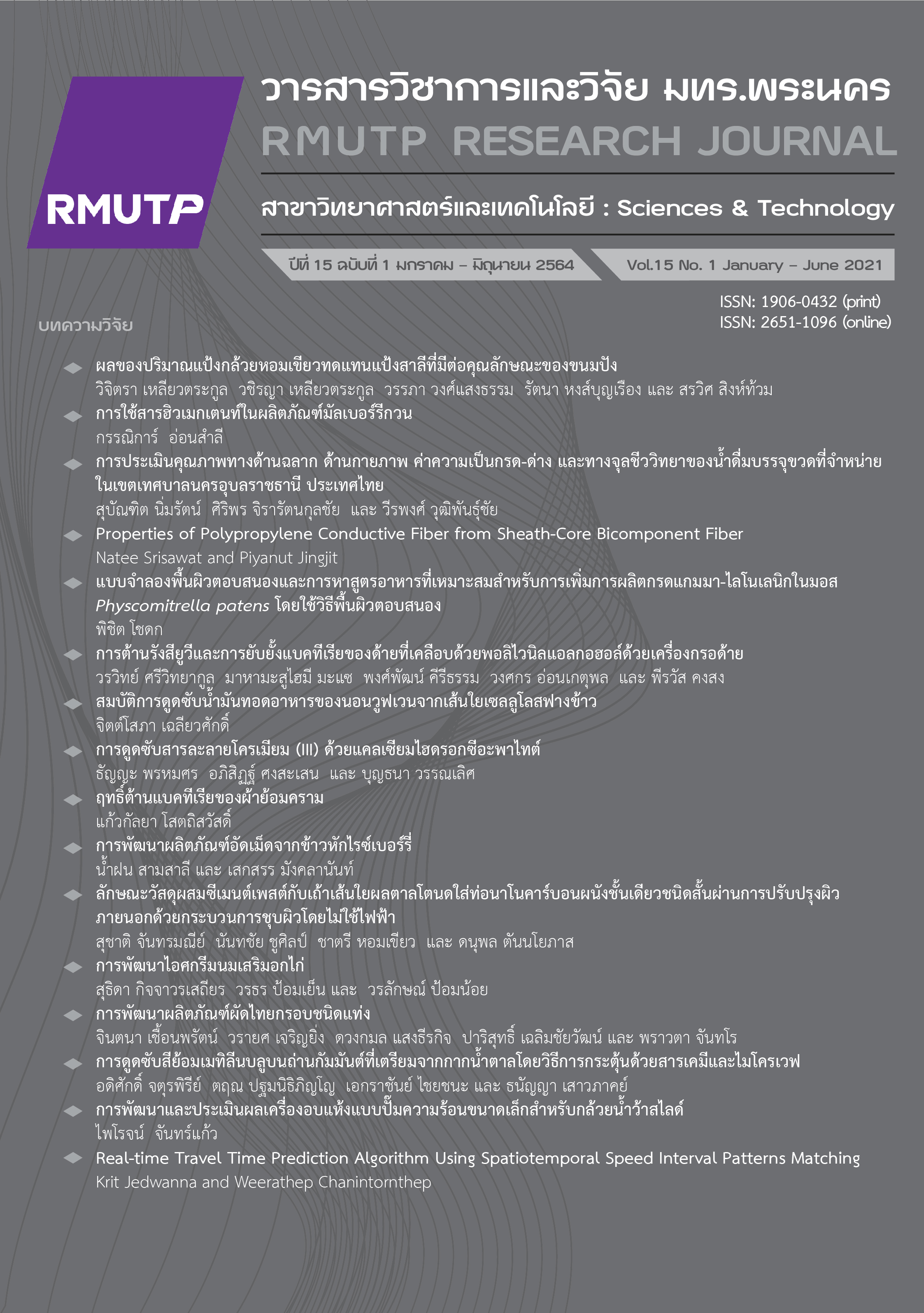การใช้สารฮิวเมกเตนท์ในผลิตภัณฑ์มัลเบอร์รีกวน
Main Article Content
บทคัดย่อ
การยืดอายุการเก็บรักษาของมัลเบอร์รีกวน โดยใช้สารฮิวเมกเตนท์ทดแทนปริมาณน้ำตาล และรักษาความชื้น ทำให้มีค่าวอเตอร์แอกทิวิตี (aw) ของผลิตภัณฑ์ลดลง การวิจัยนี้วัตถุประสงค์เพื่อศึกษาปริมาณสารฮิวเมกเตนท์ในผลิตภัณฑ์มัลเบอร์รีกวน และศึกษาการเปลี่ยนแปลงของผลิตภัณฑ์มัลเบอร์รีกวนระหว่างการเก็บรักษา ผลวิจัย พบว่า ปริมาณสารฮิวเมกเตนท์ คือ อัตราส่วนมอลทิทอล : มอลโทเดกซ์ทริน 20 : 80 (ร้อยละ 90 ของปริมาณน้ำตาลทั้งหมด) และปริมาณกลีเซอรอลร้อยละ 10 ของปริมาณน้ำตาลทั้งหมด มีส่วนผสม ได้แก่ มัลเบอร์รี มอลโทเดกซ์ทริน มอลทิทอล กลีเซอรอล เกลือ และกรดซิตริก ร้อยละ 69.73 21.62 5.40 3.01 0.17 และ 0.07 ตามลำดับ องค์ประกอบทางเคมีโดยประมาณ ได้แก่ คาร์โบไฮเดรต โปรตีน ไขมัน เถ้า กากใย ความชื้น ร้อยละ 76.92 2.39 0.14 4.19 4.30 และ 12.06 และพลังงานทั้งหมดโดยการคำนวณ 318.50 กิโลแคลอรี่ต่อ 100 กรัม ตามลำดับ ปริมาณแอนโทไซยานิน เท่ากับ 68.32 มิลลิกรัมไซยานิน-3-กลูโคไซด์ต่อกรัม ปริมาณกรดทั้งหมดในรูปของกรดซิตริก
ร้อยละ 0.60 ปริมาณน้ำตาลรีดิวซ์และน้ำตาลทั้งหมด เท่ากับร้อยละ 1.74 และ 3.90 ผู้ทดสอบที่ไม่ผ่านการฝึกฝนให้คะแนนความชอบในระดับชอบปานกลาง (7 คะแนน) ผลิตภัณฑ์เก็บรักษาในขวดแก้วที่อุณหภูมิห้อง (27 ± 2 องศาเซลเซียส) เป็นเวลา 4 สัปดาห์ พบว่า คุณภาพทางด้านกายภาพ ได้แก่ ค่าวอเตอร์แอกทิวิตี (aw) มีค่าเพิ่มขึ้น ความแข็งการเกาะติดและความยากง่ายในการเคี้ยวมีค่าลดลง คุณภาพทางด้านเคมี พบว่า ความชื้นและปริมาณแอนโทไซยานินลดลงอย่างมีนัยสำคัญทางสถิติ (p≤0.05) ปริมาณจุลินทรีย์ทั้งหมด ปริมาณยีสต์และราเพิ่มขึ้นอย่างมีนัยสำคัญทางสถิติ (p≤0.05) แต่อยู่ในเกณฑ์มาตรฐานผลิตภัณฑ์ชุมชนผักและผลไม้กวน (35/2558)
Article Details
เอกสารอ้างอิง
Y. Jiang and W. J. Nie, “Chemical properties in fruits of mulberry species from the Xinjiang province of China,” Food chemistry, vol. 174, pp. 460-466, May 2015.
Q. Yuan and L. Zhao, “The Mulberry (Morus alba L.) Fruit-A Review of Characteristic Components and Health Benefits,” Journal of Agricultural and Food Chemistry, vol. 65, no. 48, pp. 10383-10394, Dec. 2017.
L. Liang, X. Wu, M. Zhu, W. Zhao, F. Li, Y. Zou and L. Yang, “Chemical composition, nutritional value, and antioxidant activities of eight mulberry cultivars from China,” Pharmacognosy Magazine, vol. 8, no. 31, pp. 215–224, Jul.-Sep. 2012.
A. M. Pawlowska, W. Oleszek and A. Braca, “Quali-quantitive analyses of flavonoids of Morus nigra L. and Morus alba L.(Moraceae) fruits,” Journal of Agricultural and Food Chemistry, vol. 56, no. 9, pp. 3377-3380, Apr. 2008.
S. H. Bae and H. J. Suh, “Antioxidant activities of five different mulberry cultivars in Korea,” Agricultural Sciences, vol. 4, no. 6, pp. 995-962, Aug. 2007.
S. Ercisli and E. Orhan, “Chemical composition of white (Morus alba), red (Morus rubra) and black (Morus nigra) mulberry fruits,” Food Chemistry, vol. 103, no. 4, pp. 1380-1384, Dec. 2007.
M. Tomas, G. Toydemir, D. Boyacioglu, R. Hall, J. Beekwilder and E. Capanoglu, “Processing black mulberry into jam: Effects on antioxidant potential and in vitro bio accessibility,” Journal of the Science of Food and Agriculture, vol. 97, no. 10, pp. 3106-3113, Feb. 2017.
M. Tomas, G. Toydemir, D. Boyacioglu, R. Hall, J. Beekwilder and E. Capanoglu, “The effects of juice processing on black mulberry antioxidants,” Food chemistry, vol. 186, pp. 277-84, Nov. 2015.
A. F. Yesilsu and H. Temiz, “Effect of Pekmez Addition on the Physical, Chemical, and Sensory Properties of Ice Cream,” Czech Journal of Food Sciences, vol. 28, pp. 538-546, Oct. 2015.
S. Songkhrampukdee, “Quality of Life for Diabetic Patients Selaphum, Roi-Et,” Journal of Mahasarakham Hospital, vol. 9, no. 1, Apr-Jul. 2012.
G. Favetto, J. Chirife and G. Bartholomai, “Determination of moisture content in glycerol-containing intermediate moisture foods,” Journal of Food Science, vol. 44, no. 4, pp. 1258-1259, Aug. 2006.
S. Y. Quek, N. K. Chok and P. Swedlund, “The physicochemical properties of spray-dried watermelon powders,” Chemical Engineering and Processing, vol. 46, no. 5, pp. 386-392, May 2007.
R. Attabhanyo, S. Sampanvejsobha and A. Changchut, “Development of fruit for standardization and market study,” The Thailand Research Fund, Faculty of Agriculture, Department of Product Development, Chiang Mai: Chiang Mai University, 2010.
AOAC, Official Methods of Analysis of AOAC International, 18th ed. AOAC International, 2005.
M. M. Giusti and R. E. Wrolstad, “Characterization and measurement of anthocyanins by UV-Visible spectroscopy,” Current Protocols in Food Analytical Chemistry, vol. 0, no. 1, pp. F1.2.1-F1.2.13, Apr. 2001.
E. Chamber and M.B. Wolf. Sensory Testing Methods, 2nd ed., West Conshohocken, PA : ASTM, 1996.
J. H. Lane and L. Eynon, “Determination of reducing sugars by means of Fehling's solution with methylene blue as internal indicator,” Journal of the Society of Chemical Industry, vol. 42, pp. 32–36, 1923.
Standard of Preserved Vegetable and fruit paste, Thai Industrial Standard Institute, TISI. 35/ 2003.
A. Farahnaky, N. Mansoori, M. Majzoobi and F. Badii, “Physicochemical and sorption isotherm properties of date syrup powder: Antiplasticizing effect of maltodextrin,” Journal Food and Bioproducts Processing, vol. 98, pp. 133-141, Apr. 2016.
R. J. Prankerd, “Course: Formulation Chemistry II (VCF2071)” in Section two: humectants and preservatives. Victorian College of Pharmacy. Monash University. 2004, pp. 2-17.
L. O. B. Nabors, Alternative Sweeteners: Third Edition, Revised and Expanded, Marcel Dekker, Inc. New York, 2001.
V. Surojanametakul, “Glycerol;Food additives,” Food Journal (Thailand). vol. 33, no. 2, pp. 87-89, 2003.
A. Khunthawad and J. Sripui, “Effects of encapsulation by spray drying on physical properties of Mamao (Antidesma thwaitesianum) powder,” in Proceedings of 14th Graduate Research Conference, Khon Kaen, 2010, pp. 1-7.
N. Rattanapanon Author, Food chemistry, 2nd ed, Chiang Mai: Chiang Mai University Press, 2007.
H. E. Khoo, A. Azlan, S. T. Tang and S. M. Lim, “Anthocyanidins and anthocyanins: colored pigments as food, pharmaceutical ingredients, and the potential health benefits,” Food & nutrition research, vol. 61, no. 1, p. 1361779, Aug. 2017.
L.-Z. Lu, Y.-Z. Zhou, Y.-Q. Ma, Y.-L. Zhou, L.-X. Li, L. Zhou, Z.-Z. He and T. Zhen, “Anthocyanin extracts from purple sweet potato by means of microwave baking and acidified electrolysed water and their antioxidation in vitro,” International Journal of Food Science and Technology, vol. 45, no. 7, pp. 1378–1385, Jun. 2010.
R. N. Cavalconti, D. T. Santos and M. A. A. Meireles, “Non-thermal stabilization mechanisms of anthocyanins in model and food systems-An overview,” Food Research International, vol. 44, no. 2, pp. 499–509, Mar. 2011.


